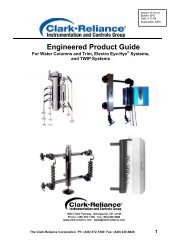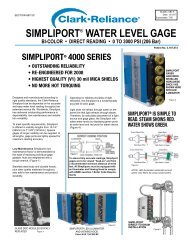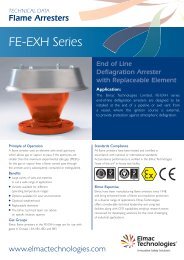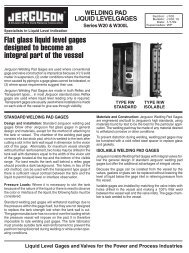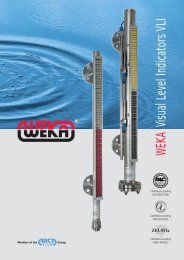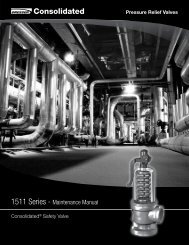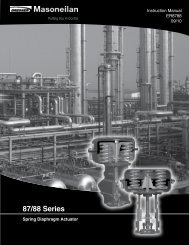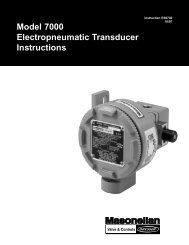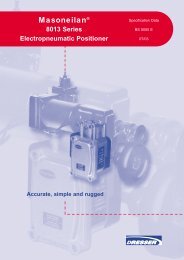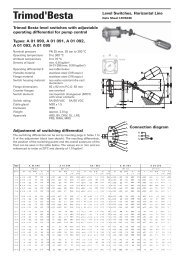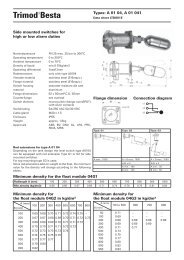Using Jerguson®/Jacoby-Tarbox® Eductors for Pumping Liquids
Using Jerguson®/Jacoby-Tarbox® Eductors for Pumping Liquids
Using Jerguson®/Jacoby-Tarbox® Eductors for Pumping Liquids
Create successful ePaper yourself
Turn your PDF publications into a flip-book with our unique Google optimized e-Paper software.
Section: E200<br />
Bulletin: E200.1<br />
Version: 1/93<br />
Supersedes: New<br />
<strong>Using</strong><br />
Jerguson®/<strong>Jacoby</strong>-Tarbox®<br />
<strong>Eductors</strong> <strong>for</strong><br />
<strong>Pumping</strong> <strong>Liquids</strong><br />
-
I<br />
JRG/JT~ Models <strong>for</strong> <strong>Pumping</strong> <strong>Liquids</strong><br />
Operating Specifications·<br />
Model Sl Ml Hl SG HG<br />
Motive Media liquid liquid liquid Steam Steam<br />
Motive Pressure (PSIG) 15-250 15·250 15·250 30-150 20-150<br />
Pressure Recovery % 10-15 30-35 40-50 15-20 30-35<br />
Maximum Suction lift -27 Ft -27 Ft -27 Ft -20 Ft -20 Ft<br />
Minimum Required NPSH 3ft 3Ft 3ft 13 Ft 13 Ft<br />
·<strong>Pumping</strong> water, 68°F<br />
Typical Applications<br />
Motive Fluid<br />
Motive<br />
Connection<br />
......1<br />
Gauge Pon<br />
liquid<br />
Pump from Tank<br />
Pump from sump<br />
Dilute in line<br />
Transport liquid<br />
,<br />
Sl, ML. Hl<br />
Suction<br />
Conneclion<br />
Suclion Chamber<br />
Steam<br />
Pump from Tank<br />
Pump from Sump<br />
Heat liquid<br />
Prime Pumps<br />
Evacuate liquid lines<br />
SG, HG, TLA<br />
......<br />
Outlet Connection<br />
Principles of Operation<br />
<strong>for</strong> <strong>Pumping</strong> LIquids<br />
<strong>Eductors</strong> operate on Ihe basic principles of<br />
flow dynamics. This involves taking a high pressure<br />
motive stream and accelerating it through a<br />
tapered nozzle to increase the velocity of the<br />
fluid (gas or liquid) that is put through the noz·<br />
zle. This fluid is then carried on through a secondary<br />
chamber where the friction between the<br />
molecules of it and a secondary fluid (generally<br />
referred to as the suction fluid) causes this fluid<br />
to be pumped. These fluids are intimately mixed<br />
together and discharged from the eductor.<br />
There are three connections common to all<br />
educlOrs.<br />
MOTIVE Connection<br />
This connection is where the power <strong>for</strong> the<br />
educlOr is generated, by increasing the velocity of<br />
the motive fluid. The JRG/JT nozzle in this section<br />
takes advantage of the physical properties of<br />
the motive fluid. <strong>Eductors</strong> with liquid motives<br />
use a converging nozzle as liquids are not generally<br />
compressible. <strong>Eductors</strong> with gas motives uti·<br />
Iize converging-diverging nozzles to achieve<br />
maximum benefit from the compressibility of<br />
the gas. All JRG/lT nozzles <strong>for</strong> eductors have<br />
smooth flow paths. Flow paths with sudden steps<br />
or roughness on these high velocity surfaces<br />
cause eductors to operate less efficiently.<br />
SUCTION Connection<br />
This connection of the eductor is where the<br />
pumping action of the eductor takes place. The<br />
motive fluid passes through the suction chamber,<br />
entraining the suction fluid as it passes. The<br />
friction between the fluids causes the chamber to<br />
be evacuated. This allows pressure in the suction<br />
vessel to push additional fluid into the suction<br />
connection of the eductor. The high \'e\ocity of<br />
the motive stream in this section of the educlor<br />
directs the combined fluids toward the outlet<br />
section ofthe eductor.<br />
OUTLET Connection<br />
As the motive fluid entrains the suction fluid,<br />
part of the kinetic energy oflhe motive fluid is<br />
imparted to the suction fluid. This allows the<br />
resulting mixture to discharge at an intermediate<br />
pressure. The percentage of the motive pressure<br />
that can be recovered is dependent upon the ratio<br />
of motive flow to suction flow and the amount of<br />
suction pressure pulled on the suction port. Th;.<br />
mixture then passes through the diverging tape'l"'_<br />
thai com'erts the kinetic energy back to pressure..<br />
The combined fluid then leaves the outlet<br />
_dn..Clott·Rdioooa:~\<br />
0\1<br />
d.......tl ~ _ n.._<br />
.._~..._ ............ _..i ~_._ ....*""-._.........._'-_ _~__
I<br />
How to Size Liquid Motive <strong>Eductors</strong> <strong>for</strong> <strong>Pumping</strong> <strong>Liquids</strong><br />
<strong>Using</strong> Liquid Motives to<br />
Pump Liquid Suction Fluids<br />
To determine the correct eductor <strong>for</strong> a spe·<br />
cifie application, follow the steps in this sec·<br />
tion, using the per<strong>for</strong>mance tables (pages<br />
3-4) provided to achieve your desired results.<br />
(NOTE: All JRG/JT tables use the 1-1/2 inch<br />
unit as the standard, and educlors are sized<br />
using a Sizing Factor (S.F.) based on this<br />
standard uni!.)<br />
Step 1 Find the suction lift* or head (Hs)<br />
that is equal 10 or greater than your desired<br />
lift.lrYOUT lift is between (wO of the lifts<br />
on the table, use an average ofthe two. You<br />
can also or use the calculated result from the<br />
NPSH <strong>for</strong>mula found on page 5 ofthis<br />
manuaL <strong>Using</strong> the NPSH number will correct<br />
<strong>for</strong> temperature variations and friction<br />
losses, resulting in a more accurate value.<br />
Step 2 Find the outlet head·· (Ho) equal<br />
to or greater than your actual outlet head. It<br />
"--iiis important to include friction losses into<br />
t e desired outlet head. (Be certain that friction<br />
losses in the outlet line are calculated<br />
using the combined rate ofborh the motive<br />
and the suction flows.) II is important that<br />
the outlet line from the eductor be as large<br />
or larger than the outlet connection.<br />
Step 3 Find the motive pressure (pm)."<br />
Locate the motive pressure from the table<br />
that is closest to or fOlrer than your actual<br />
motive pressure. The flow specified represents<br />
the Tabulated Suction Flow <strong>for</strong> each of<br />
the different models ofeductors. To determine<br />
the size ofeductor needed first use<br />
the following <strong>for</strong>mula to determine the<br />
Desired Sizing Factor (S.F.) Do this <strong>for</strong> each<br />
of the models.<br />
D . d S F Desired Suction Flow<br />
eSlre .. Tabulated Suction Flow<br />
Ifa standard unit is being used, pick the<br />
size unit that has a Tabulated S.F. (page 7)<br />
equal to or greater than the Desired S.F.<br />
Ifan exact match is desired, consult your<br />
Jergusonl<strong>Jacoby</strong>-Tarbox representative or<br />
the factory.<br />
-"<br />
Step 4 Calculate the amount of motive<br />
flow used by multiplying the Qmand Q.<br />
found in the tables by the Tabulated S.F.<br />
obtained in Step 3. Do this <strong>for</strong> each of the<br />
models ofeductors.<br />
Step j 5electthe unit from Steps 1-4 that<br />
best meets the motive and suction parameters<br />
ofthe specific application. If a turndown<br />
ratio··· ofgreater than 35% is<br />
needed, then choose two or more eductors<br />
that have the correct turndown ratio and<br />
operate these units in parallel.<br />
In some cases, the unit chosen will have<br />
the greatest suction flow while consuming as<br />
little motive fluid as possible. This is generally<br />
true <strong>for</strong> pumping applications. In orher<br />
applications, such as the dilution ofchemicals,<br />
the motive flow should be as high as<br />
possible: while the suction flow will be low.<br />
In this case, the motive flow should be<br />
matched to the desired motive flow and the<br />
suction port should be throttled to achieve<br />
the desired dilution rate. As a general rule in<br />
dilution applications, the HL is the best unit<br />
to choose.<br />
In all cases, the correct unit is the one<br />
that matches your desired range of<br />
motive-to-suction flows the closest.<br />
Correcting <strong>for</strong> Non-Water<br />
Fluid Specifications<br />
The per<strong>for</strong>mance specifications <strong>for</strong><br />
JRG/JT eductors are based on using water"<br />
with a specific gravity of 1.0 and a viscosity<br />
of I Centipoise. Fluids with differing viscosities<br />
or specific gravities need to be corrected<br />
to water, to obtain accurate<br />
per<strong>for</strong>mance estimates.<br />
Viscosity is the measure of the internal<br />
resistance ofa fluid to flow. This should be<br />
taken into consideration in most pressure<br />
drop and flow calculations within a given<br />
system. When used with JRG/JT eductors,<br />
fluids with viscosities ofless than 100 Cpo<br />
have a negligible effect. Viscosities of up to<br />
500 Cpo can be used with only small corrections.<br />
For higher viscosities (applications<br />
above 500 Cp.), we suggest that you work<br />
with your trained representative or the applications<br />
personnel at the factory. <strong>Eductors</strong> can<br />
be used with viscosities over 500 Cpo with<br />
calculated adjustments. The effects ofviscosity<br />
on the pressure drops in the line<br />
leading to the eductor must be calculated<br />
separately.<br />
Specific gravity is the measure of the<br />
weight per volume ofa liquid. The per<strong>for</strong>mance<br />
data <strong>for</strong> eductors is based on water<br />
having a specific gravity of 1.0; other specific<br />
gravities will require that adjustments be<br />
made to the per<strong>for</strong>mance table value ofthe<br />
eductors. See the topics that follow <strong>for</strong><br />
specifics on how to make these adjustments.<br />
Motive Flow Adjustments<br />
The motive flow is the amount ofliquid<br />
used to power the eductor. To adjust the value<br />
from the perfonnance table <strong>for</strong> specific<br />
gravity (Sg) of the motive fluid: Multiply the<br />
motive flow in the per<strong>for</strong>mance chart by the<br />
square root of(1I5g).<br />
Example:<br />
'Suction Lift"' vertical distance. Fl, from the suction connection to the surfact of the suction liquid source. MinllS"' below the suction connection.<br />
"Outlet Head"' 'l:nical dis1allCC. Ft. from the outlet connection to the surface Of the OU~l'1liquid destination Posith'e - aixJl'e the outlet connection.<br />
Use lero <strong>for</strong> equal to or below outlet connection.<br />
"'Turndown Ratio -(M3.\. suction now minus min. suction now) di,'ided by m3.\. iuction nO", desired.<br />
•Table data is based on "'lIter·like liouids at a temperature of68'F.<br />
50 GPM Tabulated Flow adjusted <strong>for</strong> a<br />
Specific Gravity of 1.3: 50 Y(I/1.3) =<br />
43.85 GPM Actual motive flow<br />
Suction Flow Adjustments<br />
The best way to adjust <strong>for</strong> the specific<br />
gravity or temperature effects of the suction<br />
fluid is to do the calculation <strong>for</strong> NPSH (see<br />
page 5 of this manual). If you desire a rough<br />
estimate of the specific gravity effect, multiply<br />
the suction lift by the specific gravity of<br />
the liquid. If the liquid temperature exceeds<br />
100°F, you must use the NPSH calculation,<br />
or consult your representative or the factory.<br />
Outlet Adjustments<br />
The outlet pressure of the eductor must be<br />
adjusted <strong>for</strong> the specific gravity ofthe outlet<br />
liquid, particularly if the eductor is discharging<br />
to an elevated surface. If the outlet is<br />
being measured or controlled by a pressure<br />
regulator or valve, no adjustment is required.<br />
To calculate the actual outlet pressure, multiply<br />
the feet ofelevation by the specific gravity<br />
ofthe outlet liquid.
HL. ML. Sl <strong>Liquids</strong> <strong>Pumping</strong> <strong>Liquids</strong> 1·112" Unit<br />
Suction Flow, 05 (GPM)<br />
..<br />
Mot;~ !'reiSure. I'm {PSIG)<br />
,,,<br />
....<br />
!-k(ftl '"" ""'''' Hoff , HL Ml "M' "- "<br />
'"Ml<br />
Ml "<br />
51<br />
"-<br />
140<br />
"'<br />
"<br />
" ..<br />
.. .. "<br />
" " .. " " "<br />
.10<br />
,OJ<br />
"'",<br />
.,<br />
",<br />
PSIG)<br />
o<br />
PSIG)<br />
"<br />
.,<br />
(·2.2<br />
"00'<br />
"<br />
""<br />
" '"<br />
" """<br />
'"<br />
'" '"<br />
'"<br />
'"<br />
'", ,<br />
" """'""""""<br />
'"<br />
'"<br />
'"<br />
'"<br />
'"<br />
'"<br />
'" , ,<br />
" """'""""""<br />
,,.<br />
'"<br />
,,. '"<br />
'"<br />
'", ,<br />
" """""""""<br />
HI. M1 " 51 H1 M1 '" 51 Hl<br />
40 016 41 40 016 SO 40<br />
36 39 )lI «l 016 .. «l<br />
29 30 21 31 38 35 40<br />
21 20 13 31 31 25 39<br />
14825231334<br />
19 13 29<br />
13 24<br />
"<br />
16 40 39 36 43 45 36 43<br />
12 32 29 16 40 36 16 43<br />
24 22 16 II 33 21 36 41<br />
16 \2 21 25 16 36 34<br />
9 21<br />
·<br />
16 3 31 21<br />
15 6 25 19<br />
' "<br />
" ""•<br />
34 30<br />
25 19<br />
" ,<br />
•<br />
21 27 2\<br />
21 18 6<br />
.. ,<br />
•<br />
" ""..<br />
" •<br />
'"<br />
"<br />
".. • ,<br />
,,.<br />
'" '"<br />
,,. '" '"<br />
'"<br />
_ 26.7 '.71<br />
110w lGl'Ml IS 30.6<br />
IIiSi<br />
",.<br />
".. •<br />
""<br />
" " ,<br />
'"<br />
",<br />
"<br />
".. • ,,,<br />
"<br />
",<br />
.. •<br />
117.2<br />
"<br />
" ".. •<br />
30 11 38<br />
\9 11 31<br />
1 31 31<br />
" 12 " 23<br />
25 13<br />
"<br />
24 ".<br />
16<br />
"<br />
,,11 20.9<br />
..<br />
" ,.<br />
" "•<br />
«<br />
""..<br />
,<br />
" " •<br />
" ..<br />
" ",.<br />
23 12<br />
23 10<br />
",<br />
" "<br />
36 43<br />
36 41<br />
36 35<br />
,. "<br />
",<br />
"<br />
" ""<br />
" " " "" ,<br />
" " " "".. ,<br />
"<br />
" """<br />
,<br />
13.4 24.0<br />
42.'<br />
60 &0 100<br />
5l HL Ml Sl Hl Ml Sl H1 Ml<br />
51 40 016 51 40 016 51 40 016<br />
51 40 016 51 40 016 51 40 016<br />
a 40 016 51 40 016 51 40 016<br />
39 40 016 ~ 40 016 51 40 016<br />
31 40 ~ 38 40 ~ ~ 40 ~<br />
23 40 41 30 40 ~ 43 40 ~<br />
39 39 ~ 20 40 ~ 36 40 ~<br />
31 22 5 40 31 22 40 016<br />
22 9 16 26 9 40 41<br />
13 29 16 40 12<br />
4 2263123<br />
.<br />
19 11 13<br />
",<br />
..<br />
" ".. ,<br />
"<br />
",.<br />
" " •<br />
" 16 " 41<br />
",<br />
"<br />
"<br />
.<br />
33 19<br />
" " ""<br />
" •<br />
,<br />
48 16 43<br />
48 36 41<br />
46 36 43<br />
40 36 43<br />
32 36 41<br />
24 36 41<br />
15 16 43<br />
41 45<br />
" ""<br />
41 45<br />
41 41<br />
41 11<br />
" ".<br />
12 II<br />
",.<br />
" "<br />
•<br />
" "" ,<br />
" . """" "<br />
" ,<br />
• "<br />
" ""<br />
"<br />
47.7<br />
15.5 26.<br />
,. " "<br />
26 13<br />
" ,<br />
",<br />
"<br />
" " " "'"<br />
" "<br />
..<br />
11.11 ",<br />
52.2<br />
..<br />
«"""•<br />
" ""<br />
",<br />
16 43 48<br />
36 43 48<br />
36 43 48<br />
36 43 48<br />
36 43 48<br />
16 41 48<br />
36 41 ..<br />
16 43 32<br />
" 36 " 29 "•<br />
32 19<br />
29 10<br />
.. ,<br />
"<br />
" " ""<br />
" •<br />
18 42 31<br />
31 42 11<br />
31 42 31<br />
38 40 31<br />
31 33 31<br />
31 26 31<br />
31 20 31<br />
21 7 31<br />
11 31<br />
, " """..<br />
,<br />
"_9I ,,·,<br />
" ""<br />
" " " " " " ,<br />
Sl HL '" Ml<br />
51 40 4i<br />
51 «l 4i<br />
51 40 4i<br />
51 40 4i<br />
51 40 46<br />
51 40 4'<br />
016 40 46<br />
36 40 46<br />
24 «l 4i<br />
12 «l 016<br />
I 40 31<br />
" "<br />
" """<br />
,<br />
,. "<br />
" "<br />
16 43 48<br />
16 41 48<br />
l6 43 48<br />
36 43 41<br />
36 43 48<br />
16 43 48<br />
16 41 48<br />
16 43 48<br />
16 43 16<br />
16 43<br />
.<br />
U<br />
36 34 11<br />
36 26<br />
"<br />
",<br />
" " " " " " "<br />
" "<br />
"..<br />
" •<br />
18 42 II<br />
31 42 11<br />
18 42 11<br />
38 42 11<br />
31 42 11<br />
18 18 11<br />
18 44 31<br />
18 21 11<br />
18 22 II<br />
33<br />
.<br />
10 11<br />
23 31<br />
14 11<br />
" ".. ,<br />
Sl Hl '" ML<br />
51 40 46<br />
51 40 46<br />
51 40 46<br />
51 40 46<br />
51 40 46<br />
51 40 46<br />
51 40 46<br />
51 40 016<br />
" 51 " 40<br />
" "<br />
..<br />
16 40 '"<br />
,,, " ".<br />
.""<br />
40 24<br />
""""<br />
" " "..<br />
"..<br />
" ""..<br />
•<br />
" ""<br />
" " " ., "<br />
" ., "<br />
" 38 " 42<br />
38 42<br />
"'" ",<br />
" ,<br />
'"<br />
" """"<br />
" ""<br />
" ""<br />
," "<br />
18 42 31<br />
38 42 3\<br />
38 42 31<br />
38 42 31<br />
38 42 3\<br />
31 42 31<br />
38 42 31<br />
38 42 31<br />
38 42 3\<br />
18 42 3\<br />
38 35 31<br />
38 25 3\<br />
J8 16 31<br />
38 6 3\<br />
32 31<br />
11 31<br />
, "<br />
,<br />
..<br />
" "<br />
.. "<br />
.. "<br />
14 40<br />
".<br />
,,.<br />
'" I<br />
21.71 11.7 H.S 26.61 47.6 1"".1 ~.2<br />
U8 61.2 24.3 41.3 .... 30.6 53.2<br />
""<br />
16 43 48<br />
16 41 48<br />
36 43 48<br />
l' 43 48<br />
36 414 48<br />
16 41 48<br />
16 41 48<br />
36 43 48<br />
36 41 48<br />
36 41 48<br />
36 43 44<br />
.<br />
16 41 14<br />
36 43 14<br />
36 21 4<br />
"<br />
"..<br />
33 41 45 33 41<br />
n 41 45 11 41<br />
33 41 45 11 41<br />
n 4t 45 11 41<br />
33 41 45 II 4\<br />
33 41 45 33 41<br />
II 41 45 n 41<br />
33 41 45 31 41<br />
33 41 45 n 41<br />
n 41 39 n 41<br />
n 41 29 11 41<br />
II 4\ 20 n 4\<br />
33 4\<br />
" ",<br />
" ..<br />
) 13 15<br />
" "<br />
"<br />
" " """"""<br />
" """""<br />
"<br />
",.<br />
43 48 16 43<br />
43 48 36 43<br />
43 48 36 43<br />
41 48 16 43<br />
43 48 36 43<br />
41 48 16 43<br />
43483643<br />
43 41 36 43<br />
41483641<br />
41 48 36 43<br />
43 48 36 43<br />
43 48 16 43<br />
41 36 36 43<br />
43 21 36 43<br />
31 11 36 43<br />
17 36 42<br />
'" "<br />
"<br />
45 n 41<br />
45 33 41<br />
45 11 4\<br />
45 33 41<br />
45 13 41<br />
45 11 41<br />
45 13 41<br />
45 11 4\<br />
45 31 4\<br />
45 13 41<br />
40 11 41<br />
40 31 41<br />
23 33 41<br />
o 33 41<br />
) 13 32<br />
33 22<br />
33 13<br />
" 38 " 42<br />
3. 42<br />
"<br />
" ..,<br />
"..<br />
" """""<br />
" """<br />
"<br />
" " " ""<br />
" " " "<br />
.. "<br />
46 51<br />
46 51<br />
.. ., "<br />
.. "<br />
"<br />
..<br />
""<br />
"'1 "<br />
,,¥<br />
"..<br />
".. "<br />
"..<br />
""""""<br />
•<br />
" 38 " 42<br />
38 42<br />
" ",<br />
" "..
HI., MI., SL liquids <strong>Pumping</strong> liquids<br />
1112"Unit -<br />
Suction Flow, OS (GPM)<br />
Mot~ P,~uure. Pm (PSIG)<br />
Suet Outlet 20<br />
Hslftl H ft<br />
'00<br />
" '" '" " "<br />
'" ."<br />
'00<br />
''''<br />
"' M' M' M.<br />
"'<br />
"'<br />
M' "'<br />
M'<br />
" "'<br />
M' "'<br />
M'<br />
" "'<br />
M'<br />
" "'<br />
M'<br />
" "'<br />
M'<br />
" "'<br />
M' 20<br />
, , '" " '" " '" '" " '" '"<br />
"<br />
" " " " '" """ '" '"<br />
" '" • '" '" '" '"<br />
" '" " " " , '" '" , " ,. " , '" '"<br />
'" '" '" '" '" '"<br />
20 ,<br />
'"<br />
-" "<br />
" " '" '" '" '"<br />
" " • (-u<br />
,<br />
'"<br />
", " ,<br />
" '" '" '"<br />
" •<br />
""" " '" '"<br />
'" '"<br />
'"<br />
"<br />
" • " , '00<br />
",<br />
" , " " '"<br />
'"<br />
•<br />
'"<br />
"• " " " ,<br />
'" ,"<br />
'" " ," " '" '" ,.<br />
"<br />
, " • "<br />
" " " 30 124 , ," • , 20 " " , " " ,. • , " ,. " • " • • " , ,. " ,..., -" " • , '" " " " , " "~I<br />
" • " " • " " • '00<br />
" ,<br />
'"<br />
",<br />
" " '"<br />
" ,<br />
'" '" " " '" " '" "<br />
,<br />
, , " " 20 20 " , " , , " " , 20 " • " , " " " 20 ",<br />
" , " • " 20<br />
" -20<br />
,<br />
" " • 20<br />
(·8.9<br />
• , " PSIG)<br />
" "<br />
"• " • " " • " '00<br />
,.<br />
,<br />
" • ",<br />
, "<br />
'"<br />
" ,<br />
20<br />
'" , '" " " '" • " ,<br />
'" ,.<br />
, " ,<br />
, " • " • " ",<br />
" 20 , , ,. " , " ,• ",<br />
, " " -" " • " " , " (·'0.9<br />
,<br />
'"<br />
,. " • , ~I<br />
" " • , • " • " " , '00<br />
,.<br />
,<br />
" " • " ,.<br />
'"<br />
, ,<br />
'" ",<br />
'"<br />
",<br />
'"" "• '"<br />
," "<br />
'"<br />
"<br />
•<br />
'00<br />
I Mot:(PSIGl " I '" I '" I " I " 1<br />
1 '" '" I '" ''''<br />
~1~1.<br />
" I".• ", '40.4 14.6 25.6<br />
_......... _,1"'3 "3 ".. ,,_. ,.,<br />
21.lf<br />
,,. ... ...<br />
12.4 11.1 45.6 16.$ 28.2 ,,-, ".1 "..<br />
69.0 24.' 42.2 86.2 m Sl.'<br />
roLR
I<br />
How to Determine Net Positive Suction Head<br />
Net Positive Suction Head (NPSH) is one<br />
of the most used terms <strong>for</strong> pumps (including<br />
educlors) and also one of the least understood.<br />
Simply stated PSH is a melhod of<br />
evaluating a sel ofsuction conditions <strong>for</strong> a<br />
pump. This <strong>for</strong>mula takes into account variables<br />
<strong>for</strong> the panicular liquid being pumped<br />
and the conditions under which it is being<br />
pumped. It corrects them 10 a set ofstandard<br />
conditions. This allows the user 10 reliably<br />
predict the per<strong>for</strong>mance ofa given pump<br />
when liquids with varying temperatures,<br />
specific gravities, and vapor pressures are<br />
being pumped. This <strong>for</strong>mula also corrects<br />
<strong>for</strong> friction loss in the pump suction.<br />
When being used wilh educlors, it is<br />
important that the NPSH be calculated <strong>for</strong><br />
both the motive and the suction fluids. This<br />
is because the motive fluid is also exposed<br />
to the reduced pressure in the suction chamber<br />
of the eduetor. Failure 10 consider this<br />
could resul! in the motive or suction fluid<br />
flashing to a gas as it enters the suction<br />
chamber. This would cause the eductor to<br />
pump reduced or no suction fluid, or possibly<br />
cause the moti\'e fluid to flow out the<br />
suction pon. When delermining the NPSH<br />
of both, the one with the higher vapor pressure<br />
will be the limiting liquid.<br />
NPSH should always be calculated at the<br />
centerline of the eduetor. This calculation<br />
will result in an adjusted pressure in feet of<br />
liquid (water). It must be equal to or greater<br />
thanthe PSH on the Iable (see page I)to<br />
achieve the per<strong>for</strong>mance at these conditions.<br />
NOTE: Many eductor manufacturers<br />
specify per<strong>for</strong>mance in feet of water lift at<br />
60 to 70°F. As a rule, this can be changed to<br />
NPSH by subtracting the lift from 33 Ft, or<br />
in the case ofa positive suction head by<br />
adding it to 33 Ft.<br />
Calculate the NPSH of the suction fluid<br />
by using the following <strong>for</strong>mula:<br />
NPSH' 2.JI ,(P;-Pl~ g+ Hs - Hf<br />
Hf = Friction loss in the suction piping at<br />
full flow conditions. Specified in feet of liquid.<br />
This frequently can be found in a handbook<br />
on flow through pipes if the piping<br />
arrangement is known. The JRG/JT sizing<br />
program will estimate friction loss if needed.<br />
Hs = Vertical feet that the liquid is being<br />
moved above or below the centerline of the<br />
eductor. This number will be negative if the<br />
fluid is below, or positive if it is above, the<br />
eductor.<br />
Ps = Pressure in the suction vessel in<br />
PSIA (Pounds per Square Inch AbSOIUlC). If<br />
the vessel is at atmospheric pressure, specify<br />
normal atmospheric pressure at the application<br />
site. (Normal pressure at sea level is<br />
14.7 PSIA.)<br />
Pvp = Vapor pressure of the liquid being<br />
pumped at the highest temperature that it<br />
will be pumped.<br />
To calculate <strong>for</strong> the ~rpSH of the motive<br />
fluid, change the Pvp to the vapor pressure<br />
of the motive fluid and recalculate using all<br />
other parameters of the suction conditions.<br />
To determine vapor pressure <strong>for</strong> water, go<br />
to a set ofsteam tables. If the liquid is a<br />
water-based slurry or solution, these tables<br />
will generally provide a conservative estimate.<br />
For other chemicals the vapor pressure<br />
can generally be obtained from the supplier<br />
or a chemical handbook. Estimates can be<br />
used if il is understood that these may cause<br />
some problems if the estimated value is<br />
Iov.-er Ihan the actual vapor pressure of the<br />
liquid.<br />
Sg = Specific gravity of the liquid being<br />
pumped.
I<br />
How to Size Liquid Motive <strong>Eductors</strong> <strong>for</strong> <strong>Pumping</strong> <strong>Liquids</strong><br />
r-.'Ioti\'e Liquid<br />
Quantity of Flow Available<br />
Pressure Available (in flowing condition)<br />
Specific Gravity<br />
Viscosity<br />
Temperature<br />
Vapor Pressure at Operating Temperature<br />
Suction Liquid<br />
Required Pumped Flow<br />
Lift or Head of Liquid<br />
Specific Gravity<br />
Viscosity<br />
Temperature<br />
Vapor Pressure al Operating Temperature<br />
Outlet Liquid<br />
Pressure, Lift or Head<br />
!fpressure is in outlet head, Specific<br />
Gravity of the outlet fluid will be required.<br />
Example:<br />
<strong>Pumping</strong> water at 150C>F with a suction lift<br />
of 14 Ft from the liquid surface to the center<br />
of the eductor.<br />
Hf<br />
Hs<br />
Friction loss<br />
Liquid Lift<br />
2Ft<br />
-14 Ft<br />
P3<br />
Pvp<br />
Sg<br />
Suction Pressure or<br />
Atmospheric Pressure<br />
Liquid Vapor Pressure<br />
Specific Gravity<br />
14.6 PSIA<br />
J.7J PSIA<br />
0.978<br />
Calculation using <strong>for</strong>mula above:<br />
2.31 x(14.6 -3.73)/0.978 +(-14) - 2" 9.7<br />
NPSH<br />
The suction Hs above (14.6 PSIA x<br />
2.31)10.978 will push up 34.5 feet of water in<br />
a column. There<strong>for</strong>e, the corrected suction<br />
lift is 9.7 - 34.5 = -24.8 Ft.<br />
To find the correct eductor <strong>for</strong> this application,<br />
use -25 Ft of suction lift. Then size<br />
from the tables.
I<br />
How to Size Steam Motive <strong>Eductors</strong><br />
<strong>for</strong> <strong>Pumping</strong> <strong>Liquids</strong><br />
<strong>Using</strong> Steam Motives to Pump Liquid<br />
Suction Fluids<br />
To detennine the correct educlor <strong>for</strong> a specific<br />
application, follow the steps in this section,<br />
using the perfonnance tables (pages<br />
3-4) provided to achieve your desired results.<br />
(NOTE: All JRG/JT tables use the 1-1/2 inch<br />
unit as the standard, and educlOfs aTC sized<br />
using a Sizing Factor (S.F.) based on this<br />
standard unit.)<br />
I. If the suction fluid is not water, adjust the<br />
suction and outlet head Hs and Ho<br />
by multiplying by the specific gravity<br />
of the fluid.<br />
2. Find the suction lift (Hs) that is nC
--,- NOTM SltAM11'llf.SStML iOnIlPSIGl<br />
~ ~ ~ ~ ~<br />
""""'<br />
~ ~ ~ ~ ~ ~<br />
SUCQJHW,",TUt TtMftJl.fJ\JKl,_Nl<br />
m 'M m ,~ 'M no 110 'M " .. M<br />
" " " " " " " " " ., .. .. " " " ., .. .. .. , .. " " ., ..<br />
"<br />
..<br />
" .. .. .. .. .. .. M<br />
.,<br />
.- " " " " " " " " "<br />
..<br />
" " " " ,. E<br />
M<br />
,<br />
.- ..<br />
SG. HG Steam <strong>Pumping</strong> liquids 1·112" Unit<br />
I I I I I<br />
lS T ,. 'r 'j" '1'<br />
,~ m 'M no 110 'M<br />
,~ m 'M .~ m 'M .~ m 'M ISO 110 'M .~ m 'M ISO I 10 .M .~I<br />
" " .. " " " " " " " ., ., .. ., .- ..<br />
., " .- M .. " " ., ., " " "<br />
.. " ..<br />
" ,. " .. .. " .- "<br />
" "<br />
"<br />
.. " " " .. .- .. .- (2.2 .. .. " " " " " " " " .- f'SIG)<br />
.. ..<br />
" ,. " " " .- " .- .. " .. .. .- " "<br />
.. .- '00 .. .. .- ..<br />
E<br />
E ,.<br />
'" ,.<br />
, .. " E E<br />
E<br />
" '" '" '" " .. " .. .. " '" '" ., " " " " " .. .. " '" '" ., " " " ,. " '" " ., " " .. .. '" E<br />
(-2.2<br />
.. " " " '" " " " " " " .. """ " " " " " " ..<br />
" " " "<br />
.. '00<br />
, .. .. " " " .. " n " " " " " " " .. ... n " " " " .. " " .. .. ., " " " " " " " " " " " " " " "<br />
n<br />
" "<br />
.. n<br />
I"" n<br />
.,<br />
" " """ " " n<br />
.. " " " " " " '00<br />
" "<br />
, .. .. " " " .. " " " " " .. " " " " " " " " " " " " " "<br />
.. " " " "<br />
." " " " " " " " " n " " "<br />
..<br />
I·U<br />
" " " "<br />
" " " " " """ " " " n<br />
" " " " " .00<br />
, "<br />
" "<br />
n " " .. " .. E<br />
E<br />
" " " " " "<br />
..<br />
" " " .. E<br />
" " " " " " " "<br />
·20<br />
(-8.9<br />
f'SIG)<br />
" " " " .. " " " " " " "<br />
" " " " .. " " " " " "<br />
" " " " --'00<br />
I<br />
"<br />
-~- m '" ." m<br />
'" '" '" '" ", Ion<br />
_..<br />
07.1 ."<br />
'"<br />
M'<br />
I<br />
'" '" '" '" '" '" ''''<br />
floo
I<br />
Dimensions<br />
.__._.~-_._..~._._._.<br />
Models SL, ML, Hl, SG, HG.t- @ _<br />
@NPT<br />
I~~<br />
©<br />
! 2<br />
1/4 0) NPT<br />
rOR P!l($SURE TAP<br />
SIZES 1 I/~ IHIW 3<br />
(OP11l)N.O,L)<br />
(G) NPT ,OR<br />
PF
I TOCONVERT INTO MUlTIPLY BY TO CONVERT INTO MUlTIPLY BY<br />
A<br />
otm emHg 7. joule/em 'b 22.48<br />
otm ft H 1 0 33.9<br />
otm in Hg 29.92 K<br />
otm PS' 14.7 kiloliter liter 1,000.0<br />
kg 'b 2.205<br />
B<br />
bot otm 0.9869<br />
..., kglsq meter 1.020 x 10" L<br />
..., PS' 14.50 liter eu em 1,000.0<br />
barrel g.' 42 litet wn 0.03531<br />
liter co in 61.02<br />
C liter g.' 0.2642<br />
Centigrade Fahrenheit (C x 915)+32<br />
em Hg otm 0.01316 M<br />
em Hg tt H 1 0 0.4461 meter
8~.". ...... """.<br />
.. ,..<br />
JERGUSON®/<br />
JACOBY·TARBOX®<br />
OMstOnS ol The CrarI




